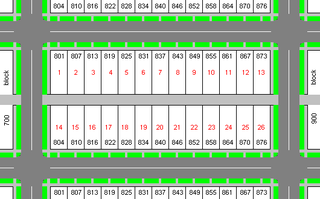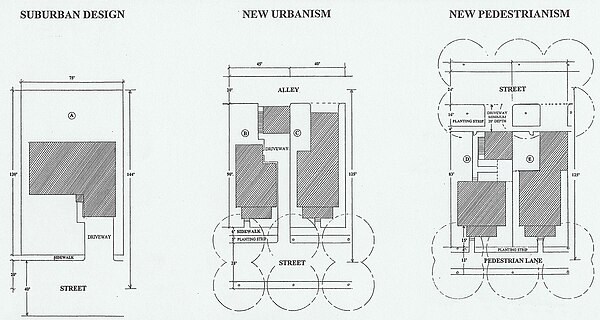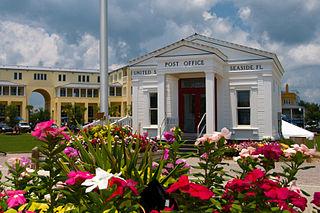
Traffic calming uses physical design and other measures to improve safety for motorists, pedestrians and cyclists. It aims to encourage safer, more responsible driving and potentially reduce traffic flow. Urban planners and traffic engineers have many strategies for traffic calming, including narrowed roads and speed humps. Such measures are common in Australia and Europe, but less so in North America. Traffic calming is a calque of the German word Verkehrsberuhigung – the term's first published use in English was in 1985 by Carmen Hass-Klau.

Radburn is an unincorporated community located within Fair Lawn in Bergen County, New Jersey, United States.

A street is a public thoroughfare in a built environment. It is a public parcel of land adjoining buildings in an urban context, on which people may freely assemble, interact, and move about. A street can be as simple as a level patch of dirt, but is more often paved with a hard, durable surface such as tarmac, concrete, cobblestone or brick. Portions may also be smoothed with asphalt, embedded with rails, or otherwise prepared to accommodate non-pedestrian traffic.
Urban studies is the diverse range of disciplines and approaches to the study of all aspects of cities, their suburbs, and other urban areas. This includes among others: urban economics, urban planning, urban ecology, urban transportation systems, urban politics, sociology and urban social relations. This can be contrasted with the study of rural areas and rural lifestyles.

A dead end, also known as a cul-de-sac, no through road or no exit road, is a street with only one inlet or outlet.

Pedestrian zones are areas of a city or town reserved for pedestrian-only use and in which most or all automobile traffic may be prohibited. Converting a street or an area to pedestrian-only use is called pedestrianisation. Pedestrianisation usually aims to provide better accessibility and mobility for pedestrians, to enhance the amount of shopping and other business activities in the area and/or to improve the attractiveness of the local environment in terms of aesthetics, air pollution, noise and crashes involving motor vehicle with pedestrians. However, pedestrianisation can sometimes lead to reductions in business activity, property devaluation, and displacement of economic activity to other areas. In some cases traffic in surrounding areas may increase, due to displacement, rather than substitution of car traffic. Nonetheless, pedestrianisation schemes are often associated with significant drops in local air and noise pollution, accidents, and frequently with increased retail turnover and increased property values locally. A car-free development generally implies a large scale pedestrianised area that relies on modes of transport other than the car, while pedestrian zones may vary in size from a single square to entire districts, but with highly variable degrees of dependence on cars for their broader transport links.

The car-free movement is a broad, informal, emergent network of individuals and organizations including social activists, urban planners, transportation engineers and others, brought together by a shared belief that large and/or high-speed motorized vehicles are too dominant in most modern cities. The goal of the movement is to create places where motorized vehicle use is greatly reduced or eliminated, to convert road and parking space to other public uses and to rebuild compact urban environments where most destinations are within easy reach by other means, including walking, cycling, public transport, personal transporters, mobility as a service, ...

Pedestrian malls, also known as pedestrian streets, are the most common form of pedestrian zone in large cities in the United States. They are typically streets lined with storefronts and closed off to most automobile traffic. Emergency vehicles may have access at all times and delivery vehicles may be restricted to either limited delivery hours or entrances on side streets.

A city block, urban block or simply block is a central element of urban planning and urban design.

Transportation Alternatives is a non-profit organization in New York City which works to change New York City's transportation priorities to encourage and increase non-polluting, quiet, city-friendly travel and decrease automobile use. TransAlt seeks a transportation system based on a "Green Transportation Hierarchy" giving preference to modes of travel based on their relative benefits and costs to society. To achieve these goals, T.A. works in five areas: Cycling, Walking and Traffic Calming, Car-Free Parks, Safe Streets and Sensible Transportation. Promotional activities include large group bicycle rides.

A car-free city or carfree city is a population center that relies primarily on public transport, walking, or cycling for transport within the urban area. Carfree cities greatly reduce petroleum dependency, air pollution, greenhouse gas emissions, automobile crashes, noise pollution, urban heat island effect and traffic congestion. Some cities have one or more districts where motorized vehicles are prohibited, referred to as car-free zones.

Walkability is a measure of how friendly an area is to walking. Walkability has health, environmental, and economic benefits. Factors influencing walkability include the presence or absence and quality of footpaths, sidewalks or other pedestrian rights-of-way, traffic and road conditions, land use patterns, building accessibility, and safety, among others. Walkability is an important concept in sustainable urban design.

The Detroit International Riverfront is a tourist attraction and landmark of Detroit, Michigan extending from the Ambassador Bridge in the west to Belle Isle in the east, for a total of 5.5 miles. The International Riverfront encompasses a cruise ship passenger terminal and dock, a marina, a multitude of parks, restaurants, retail shops, skyscrapers, and high rise residential areas along with TCF Center. The Marriott at the Renaissance Center and the Robert's Riverwalk Hotel are also situated along the International Riverfront. Private companies and foundations together with the city, state, and federal government have contributed several hundred million dollars toward the riverfront development. Key public spaces in the International Riverfront, such as the RiverWalk, Dequindre Cut Greenway and Trail, William G. Milliken State Park and Harbor, and a cruise ship passenger terminal and dock at Hart Plaza complement the architecture of the area. The area provides a venue for a variety of annual events and festivals including the Detroit Electronic Music Festival, Detroit Free Press International Marathon, the Detroit International Jazz Festival, Motor City Pride, the North American International Auto Show, and River Days.

New Urban Cowboy: Toward a New Pedestrianism is a 2007 documentary film, and DVD release, about American artist and urban designer Michael E. Arth, his New Pedestrianism movement, and his efforts to rebuild the cities, beginning with "Cracktown," an inner city slum in DeLand, Florida. This 83-minute international edition—with subtitles in Spanish, French, German, Japanese, and Chinese—was re-edited from a 100-minute version that made the film festival circuit in 2007. The earlier version was titled New Urban Cowboy: The Labors of Michael E. Arth.

A pedestrian village is a compact, pedestrian-oriented neighborhood or town, with a mixed-use village center, that follows the tenets of New Pedestrianism. Shared-use lanes for pedestrians and those using bicycles, Segways, wheelchairs, and other small rolling conveyances that do not use internal combustion engines. Generally, these lanes are in front of the houses and businesses, and streets for motor vehicles are always at the rear. Some pedestrian villages might be nearly car-free with cars either hidden below the buildings or on the periphery of the village. Venice, Italy is essentially a pedestrian village with canals.

A transit mall is a street, or set of streets, in a city or town along which automobile traffic is prohibited or greatly restricted and only public transit vehicles, bicycles, and pedestrians are permitted.

Radburn design housing is a concept for planned housing estates, based on a design that was originally used in Radburn, New Jersey, United States.

Democracy and the Common Wealth: Breaking the Stranglehold of the Special Interests is a 2010 book by urban designer, policy analyst and artist Michael E. Arth. Arth attempts to expose what he calls the "dirty secrets" of America's electoral system, and provides a list of solutions that he believes will result in a "truly representative democracy." This democracy would be led by effective, trustworthy leaders, who would be elected by a majority, and who would not have to spend their time raising campaign funds, or catering to paid lobbyists.




























